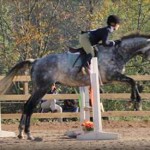Senior Editor
[divider]
F&M has a wide variety of clubs and club teams for students to participate in. The College has everything ranging from F&M Paintball to a Quidditch Team. There is so much variety that many clubs often fly under the radar. One of these teams, which has been around for a few years but has not gotten campus-wide attention, is the F&M Equestrian Team.
The Equestrian Team has been at the College since 1999 and has experienced rapid growth within the last year, doubling in size and bringing its roster to 25 people. There is a wide range of experience on the team, ranging from people who have never ridden prior to joining to riders who have ridden all their lives, own their own horses, and compete in high-level shows outside of college competitions.
The team has three people who run their operations; two captains, who handle most of the team’s affairs such as fundraising, transportation, and show preparations, and the lesson chair, who organizes the team’s lessons.
Equestrian, in the context of the Equestrian Team, is competitive horseback riding where riders are judged on their proficiency and skill at controlling not only their horse but also themselves and their positioning on the horse while completing certain tasks and courses.
Equestrian competitions are divided into two broad classes, which are then divided further into smaller classes. The two broad classes are the jumping and the flat class.
As the name implies, the jumping classes are focused on rider control and posture while navigating a specified course of hurdles, referred to as fences, and is broken into novice, intermediate and open divisions. The subdivisions of the jumping classes are based off of fence height.
The flat class is judged on control and posture while bringing the horse through varying speeds and is divided into walk, trot, and canter. In both classes, the scoring is based off of the rider’s control of the horse, positioning on the horse, and control over his or her own posture.
The Equestrian Team competes in shows as part of the Inter-Collegiate Horse Show Association (IHSA). As part of the IHSA, the
Team competes in shows against 10 other schools, of which the most notable are Princeton University and Penn State University Berks Cam- pus, F&M’s biggest competitors.
Because they are part of the IHSA, the shows are structured differently than other forms of Equestrian shows. The major difference is in the horses that the riders have to compete with.
“When we arrive at the horse shows, we are randomly assigned a horse instead of riding a horse that we are familiar with,” said Katherine Lembeck ’13, co-captain of the Equestrian Team. “They do this in order to test your ability as a rider as opposed to your familiarity with the horse.”
In other equestrian shows, the rider comes with a horse they either own or are very familiar with and have ridden many times before.
In a typical season, the team will have up to 10 shows, most of which occur in the fall. In each of those shows, there is a point system which determines which riders and which teams move on in the region. Each position has a certain number of points assigned to it with first place being worth seven points, second place worth five points, third place worth four, etc. When a rider gets 36 points, the rider “points out” and moves on to regionals for that class and moves into the next class for next semester. Every rider’s points also add together for the team and the team with the most points in the region moves on to regionals. From regionals, the top two riders move on to zones and the top two from zones then move to the national competition.
The Equestrian Team has been holding its own in terms of placing into the higher level competitions. Max Sechzer ’14, co-captain of the Equestrian Team, placed into zones this year and Lembeck placed in the previous year.
“We are hoping to go to nationals,” Lembeck said. “The worry is that it is really up to the luck of the draw. When you get to the level where all of the riders are really good it comes down to the horse you get.”
As the team moves forward, they are always looking for new members.
“An interest in learning is all that is required to join the team and any- one with any level of experience is able to join,” Lembeck said.
If you are interested in learning more about the team or in joining, email maxwell.sechzer@fandm.edu.
[divider]
justin.kozloski@fandm.edu

